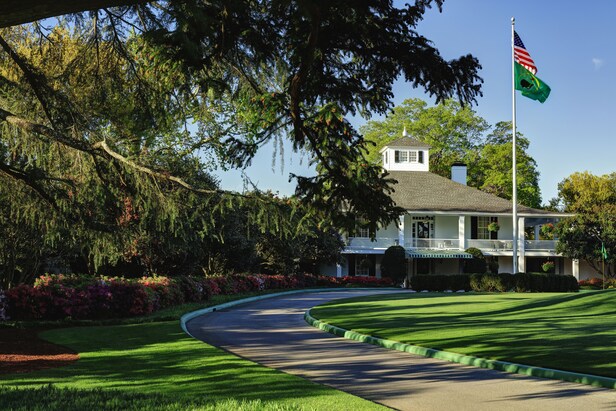I failed to teach my son about the Masters. He was into motorcycles and girls, not golf. When he decided to marry a girl who rode motorcycles, he chose an April day for the ceremony. His wedding day was April 13, 1986.
Historians in the audience may remember April 13, 1986, for more than my son’s wedding. It was also the day that old Jack Nicklaus got young again. He shot 65 and won the Masters a sixth time. Meanwhile, 545 miles from Augusta, I ate cake at a wedding reception, after which I advised my son, “Next time you get married, DO NOT do it in April.”
Except for that day, I have covered every Masters since 1967. But I won’t be there this time. Unwilling to dance in a pandemic, I’ll sit out this one and watch it on television along with most everyone else.
This will be the silent Masters.
No spectators on the grounds. Only players and caddies.
I was behind the second green in 2012 when Louis Oosthuizen’s second shot on the par-5 began a long, long roll across the green toward the flagstick. Who knows how many people were there, a thousand maybe? We watched the ball rolling and with each foot of roll the thousand voices grew from murmur to shout. We saw what was happening. Ten feet from the hole, the noise became a roar because that ball was not stopping. When it fell over the lip and out of sight, the rising roar became an abrupt explosion. Those thousand people had seen history, a double eagle, and had recorded it.
It won’t be that loud this time.
Later that afternoon, I was in a small crowd behind Bubba Watson in the trees to the right of the 10thfairway, the first hole of a sudden-death playoff with (perfectly) Oosthuizen. Bubba had a wedge in hand. The reasonable shot was to bump it straight back into the fairway. But Bubba hits curves. His draw on the wedge made a right-angle turn. Not that we saw the ball’s flight out of the dark of the trees. We heard where it went. A roar came from the green, an oh-my-God roar. Bubba’s improbable play had produced an implausible result. Moments later he had won the Masters.
This time, if anyone hits that same shot, silence.
Well, OK. There’ll be no Augusta roars. I’m good with that. Just give me the Masters. The coronavirus stole it from us in April. The world had gone to hell in a hand basket, a thousand and more Americans dying every day, and no one knew when or if the horror would end. We lost March Madness and baseball’s spring and the winters of the NBA and NHL. That was bad. It got worse in late March when Augusta National announced there’d be no Masters in April.
No Masters was no good. It’s Bobby Jones’s creation. It’s golf’s cathedral in the pines. It’s every hacker’s dream destination and every pro’s favorite event. The saving grace to Augusta’s postponement was the club’s plan to play the tournament later. Now, happily, we have arrived at later.
The virus is still here, still killing Americans, and the presidential election showed how divided we are in these United States. But there are suggestions we’ll somehow sometime find a way to a new normal. Baseball pulled off a World Series and LeBron James won another NBA championship and Tampa Bay paraded with Lord Stanley’s Cup. Now it’s the Masters turn on-stage, an old friend giving us another chance to remember how good this world can be.
One thing is certain. This Masters will be unique among Masters. It will be like no other and it will be like them all. This takes some explaining.
There’ll be no spectators. None in their usual spots behind the second green or encircling the 7th. There’ll be none in Amen Corner or in the top row of the bleachers by the pond at 15 where, if you lean over the railing and past the security guy, you can also catch the tee shots at 16. Old friends in the habit of annual reunions at the putting green will have to meet by Zoom from home. The dreamer’s image of Augusta National is a watercolor with tens of thousands of smiling people in pastels idling under skyscraping loblolly pines and alongside impossibly vivid azaleas. This time the painting would be a landscape done in shades of green without a pastel in sight. Beautiful … and ghostly.
As for the caliber of the golf in these most unsettling of times, let me ask …
Did you see the World Series? I had no interest. A 60-game season, cardboard fans in the stands, the Series played in a ballpark that belonged to neither team? But then came Randy Arozarena. The kid from outback Cuba hit 10 home runs in the postseason. On a single he rocketed from first base to home, diving in, slapping the plate in triumph, winning Game 4 on Tampa Bay’s last at-bat. Arozarena didn’t need real fans in the stands to be at his best when it mattered most. Nor did the crafty old pitcher, Clayton Kershaw, need 50,000 fans to win twice for the Dodgers and certify his Hall of Fame credentials. It became a true and wonderful World Series.
This Masters will be just as true, just as wonderful. There were no spectators at the U.S. Open and Bryson DeChambeau blew away the mere mortals. Another phenom out of nowhere, Collin Morikawa, won the PGA Championship while the only people rooting for him stood behind a fence bordering Harding Park. Morikawa, DeChambeau and Morikawa were in a world of their own making. The only sound they needed came from the beating of their hearts.
On April 13, 1986, at age 46, Jack Nicklaus heard the cheers and loved the roars and for two hours on the back nine he walked to each shot through a tunnel of noise. But the thousands of people along the way did not carry him. By playing flawlessly when only flawless golf could win, he carried the crowd with him. On that day, do you think Jack Nicklaus needed anyone except Jack Nicklaus?
That was the Masters being the Masters, and the Masters this time will be the Masters again. Only in a softer voice.

